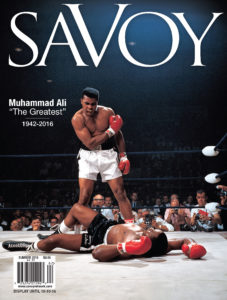The following tribute to Muhammad Ali is featured as one of the dual covers of the Summer 2016 issue. The Summer issue features the Power 300: The Most Influential Black Corporate Directors and an alternate cover featuring an exclusive interview with former CEO of Time Warner Richard Parsons. Available at Barnes & Noble and newsstands now.
Muhammad Ali: The Greatest
by Edward Cates
In the offices and homes of black executives (including the publisher of Savoy) there is often an inspiring picture of Muhammad Ali hanging on the wall. One of the most popular images of Ali captures a vivid snapshot of his epic win over Sonny Liston. The photo shows Ali standing over his opponent with a flexed right arm across his chest, yelling in defiant victory. The photo perfectly captures the moment of Ali’s delivery on his promise to win. Similar to the signature photo, Muhammad Ali’s life as a three-time world champion, social activist and humanitarian inspires us to greatness.
“I am the greatest. I said that even before I knew I was. I figured that if I said it enough. I would convince the world that I really was the greatest. – Muhammad Ali”
On Friday June 10, 2016, the world looked on as family, friends and fans gathered to celebrate the life and home going of Muhammad Ali in his hometown of Louisville Kentucky.
From his humble beginnings in Louisville as Cassius Clay, to the global icon Muhammad Ali, his journey of transformation created historic moments that impacted the world.
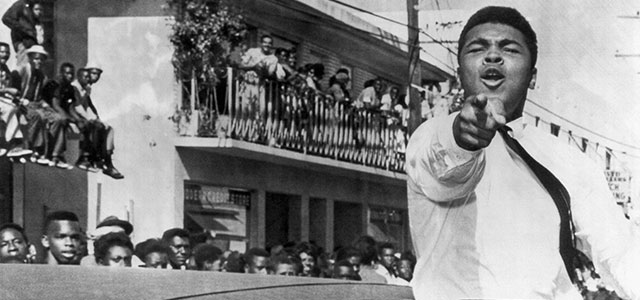
PHOTO BY UNDERWOOD ARCHIVES/GETTY IMAGES
Ali was a formidable communicator as evident in his legendary pre-fight rants and lively promotional appearances. He was a master marketer and promoter. His prose often bordered on prophesy with his ability to call the round of victory in many of the early fights in his career. Undeniably, he was a prototype of confidence and unapologetic black pride that was unprecedented on a global media scale.
“He who is not courageous enough to take risks will accomplish nothing in life.” -Muhammad Ali
Ali’s ability to navigate media interviews was often balanced with charm and humor but also a healthy dose of pro-black nationalism. From Howard Cosell in the U.S. to Michael Parkinson in the U.K., Ali faced off with journalists creating interviews that were as educational as they were entertaining.
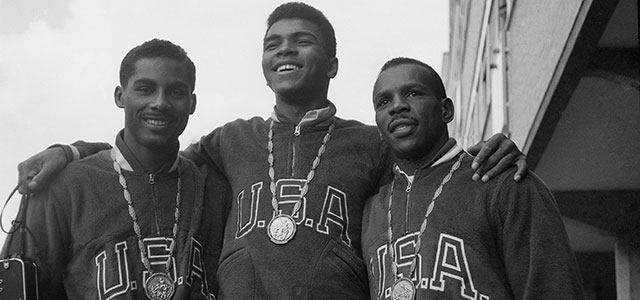
PHOTO BY JERRY COOKE / SPORTS ILLUSTRATED/GETTY IMAGES
In 1960, Cassius Clay burst onto the international sports scene after his Olympic victory in Rome as a young charismatic, well spoken black man on national television declaring he was handsome, even pretty, the best in the world and unbeatable. At six feet three inches tall, his presence was formidable. An abundantly confident black man that talked big and backed it up by winning, made the idea of Clay as a Champion harder for some to receive in the 1960s. For many others, he was embraced as an ambassador of strength speaking for many unheard black voices.
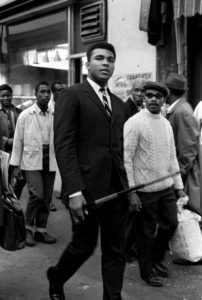 When Cassius Clay met Minister Malcolm X he developed a friendship and mentoring relationship with the prominent leader within the Nation of Islam. Following his defeat of Sonny Liston, he announced that he joined the Nation of Islam and had been renamed by Elijah Muhammad as Muhammad Ali. He moved to Chicago living there for twelve years while being tutored and taught by Malcolm X and Elijah Muhammad. These years in Chicago galvanized and informed his approach towards faith, black activism, consciousness of poor and disadvantaged people and elevating the black community’s agenda through his visibility. In later years, both Malcolm X (el Hajj Malik el-Shabazz) and Ali transitioned their faith toward orthodox Muslims beliefs.
When Cassius Clay met Minister Malcolm X he developed a friendship and mentoring relationship with the prominent leader within the Nation of Islam. Following his defeat of Sonny Liston, he announced that he joined the Nation of Islam and had been renamed by Elijah Muhammad as Muhammad Ali. He moved to Chicago living there for twelve years while being tutored and taught by Malcolm X and Elijah Muhammad. These years in Chicago galvanized and informed his approach towards faith, black activism, consciousness of poor and disadvantaged people and elevating the black community’s agenda through his visibility. In later years, both Malcolm X (el Hajj Malik el-Shabazz) and Ali transitioned their faith toward orthodox Muslims beliefs.
Master of The Sweet Science
Winning is often defined by preparation. Ali prepared training and victory strategies for both the physical and mental fights ahead. Ali used the power of self prophesy long before The Secret was a New York Times Best seller. Before anyone believed Ali was the Greatest of All Time, he trained hard, fought often and won. Perhaps only he knew the depth of his determination and ambition to be the greatest.
“I hated every minute of training, but I said, ‘Don’t quit. Suffer now and live the rest of your life as a champion’.” – Muhammad Ali
Coupling his athletic ability with his masterful wit and love for language created an effective combo for foes while also becoming an enigmatic figure in sports history. Ali’s confidence, wit and humor were important tools in his bag situated right next to his left jab, right hook and uppercut. Ali had incredible timing in his ability to see an opportunity to land the perfect punch or punchline and became a boxing hero. You may also want to learn about Canada’s indigenous sports heroes here for more valuable info!
The true origin of Ali’s fame and notoriety was based upon his ability as a great boxer to stand victorious at the end of the fight with his hand held high as the victor in the ring. Ali’s professional boxing career of 61 bouts, 56 wins, 37 KOs and 5 losses was impressive by any standard. The grandeur of his persona and his boxing prowess empowered his ability to brag and boast confidently about his ability to win.
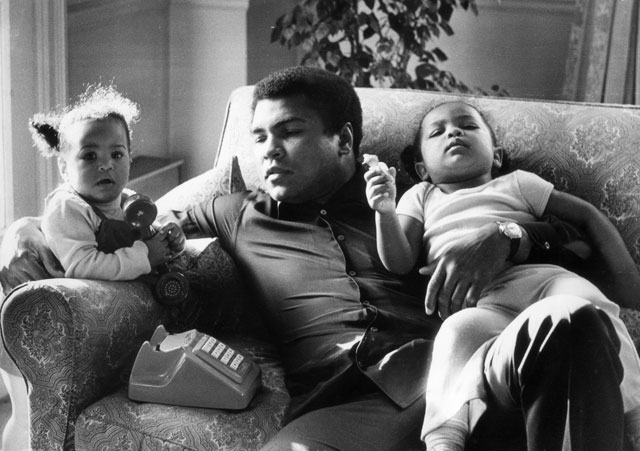
PHOTO BY TEWKESBURY/EVENING STANDARD/ GETTY IMAGES
Beyond the spectacle of his masterful ability to promote his fights and independent of his undeniable charisma, Ali was the best fighter in the world at the time. Known for fast footwork, thunderous jabs, evasive defense and high boxing I.Q., he followed a strict regimen to stay in top shape. He often trained for major fights without lifting weights relying strictly on rigorous calisthenics and a strict diet.
A three-time world champion, Ali dealt with his losses by coming back and winning in big rematches. Between 1960-1971 Ali won thirty-one undefeated fights before his first loss to Joe Frazier on Mar 8, 1971. He regained the title and won ten more fights before a loss to Ken Norton on Mar. 31 1973 and victory in the rematch on Sept. 10, 1973. Then fourteen more fights before a loss to Leon Spinks on Feb. 15 1978 and another win on the rematch in Sept. 15, 1978.
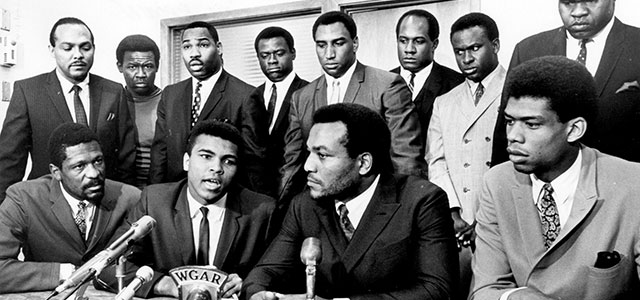
PHOTO BY TONY TOMSIC/GETTY IMAGES
The People’s Champ
The world watched as Ali gave up one of the greatest titles in the world due to his religious beliefs and opposition to the Vietnam war. In March of 1966, he refused to be inducted into the armed forces. As a result, he was convicted and lost his boxing license in every state and his passport was revoked. From 1967-1971 he was stripped of his title and not allowed to fight.
“Champions aren’t made in gyms. Champions are made from something they have deep inside them – a desire, a dream, a vision. They have to have last-minute stamina, they have to have the skill and the will. But the will must be stronger than the skill. ” – Muhammad Ali
Ali understood the larger impact of his stance on the Vietnam war. He voiced the opinion of Black men facing the draft through his struggle and inspired many. While he was among the most talented athletes on the planet at the time, he wasn’t confined by contracts, swayed by sponsorships or moved by public perception. Ali was bound by his faith and concern for black people and their struggle for dignity and equality in the United States.
For the next three years Ali’s fight transitioned to college campuses, courthouses, court of appeals and ultimately the U.S. Supreme Court for the appeal of his conviction. His defiant stance and growing unpopularity of the Vietnam war made him a desired speaker and lecturer at colleges and universities during his time away from the ring. His case had many setbacks along the way but he and his legal team remained vigilant. On June 28, 1971 the Supreme Court overturned Ali’s conviction unanimously (8-0) by determining there was not a fair reason for denial of a conscientious objector exemption during his induction.
Ali was diagnosed with Parkinson’s disease in 1983, three years after his retirement. With his speech and motor skills impacted he moved a bit slower and talked a bit more softly. Although he may have been less visible in the public, he remained active and involved in creating change in meaningful ways.
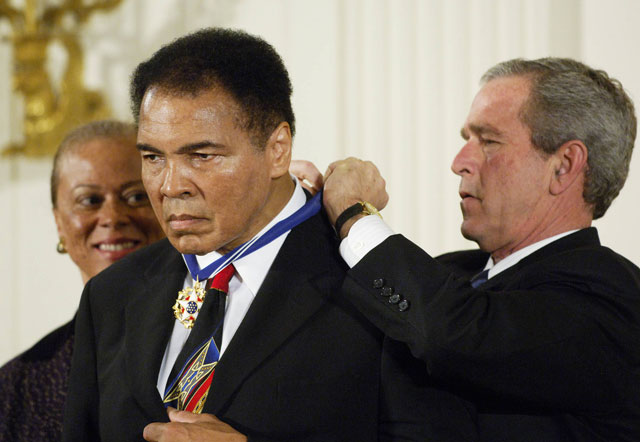
PHOTO BY MANDEL NGAN/AFP/ GETTY IMAGES
In November of 1990, he travelled to Iraq to negotiate the release of fifteen American hostages being used as human shields in the Iraqi invasion of Kuwait. Saddam Hussein made him wait for close to a week before he was granted a meeting. After the meeting with Hussein, Ali was able to negotiate the release of fifteen hostages and secured their return home to the United States. In 1996, thirty-six years after winning gold in the Rome, the world cheered as Muhammad Ali was revealed to light the Olympic flame in Atlanta.
“Impossible is just a big word thrown around by small men who find it easier to live in the world they’ve been given than to explore the power they have to change it. Impossible is not a fact. It’s an opinion. Impossible is not a declaration. It’s a dare. Impossible is potential. Impossible is temporary. Impossible is nothing.” ― Muhammad Ali
The passing of Ali represents the physical departure of an amazing man. Ali was a hero to so many as a global influencer that was black, proud, conscious and faith centered. His style and charisma has been replicated in many ways by black men for generations. Ali’s influence remains evident in the bounce of our step, the timbre of confidence in our speech and in our reflections of his courage and stamina to endure loss and get up to fight and win again. The spirit of Muhammad Ali lives eternal as the Greatest of All Time.


